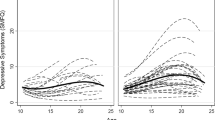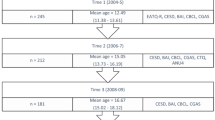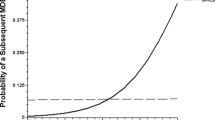Abstract
Few studies have examined risk factors of childhood and early adolescent depressive symptomatology trajectories. This study examined self-report depressive symptomatology across a 6-year time period from 2nd to 8th grade to identify latent groups of individuals with similar patterns of depressive phenomena in a sample of 951 children (440 girls, 511 boys). Analyses, using semiparametric group modeling (SGM), identified 5 trajectory groups for girls and boys: low depressed stables, low depressed risers, mildly depressed stables, moderately depressed changers, and moderately depressed risers. Individual risk factors, with the exception of shy/withdrawn behavior, were significantly different across trajectory group membership for boys and girls, as was low-income status for boys. Boys in the low depressed and mildly depressed stable trajectory groups had significantly higher levels of antisocial behavior, attention problems, and lower social competency compared to girls in similar groups. These results suggest that universal prevention programs implemented in early elementary school that target selected risk factors may be helpful in reducing future adolescent mental health problems, specifically depressive symptomatology.


Similar content being viewed by others

Notes
Since some of the students in this sample are part of the program condition in a prevention experiment, preliminary analyses were conducted to examine whether the program affected the predictive relationships among experimental and control groups. The results indicated that the covariance structures were not different between experimental and control groups, nor did depressive symptoms trajectory group membership differ by experimental condition. Based on these results, the data for the experimental and control groups were combined in the subsequent analyses.
It should be noted that SGM was also done using Mplus, allowing the slopes to be free rather than fixed (i.e., Nagin 1999). Results of the Mplus analyses were similar to the Nagin analyses, and given the parsimonious structure of the Nagin method, we choose this methodology.
References
Achenbach, T. M. (1991). Manual for the Teacher’s Report Form and 1991 Profile. Burlington: University of Vermont Department of Psychiatry.
Altmann, E. O., & Gotlib, I. H. (1988). The social behavior of depressed children: An observational study. Journal of Abnormal Child Psychology, 16, 29–44. doi:10.1007/BF00910498.
Angold, A., & Costello, E. J. (1993). Depressive comorbidity in children and adolescents: Empirical, theoretical, and methodological issues. The American Journal of Psychiatry, 150, 1779–1791.
Angold, A., Costello, E. J., & Erkanli, A. (1999). Comorbidity. Journal of Child Psychology and Psychiatry, and Allied Disciplines, 40, 57–87. doi:10.1111/1469-7610.00424.
Aseltine, R. H. J. (1996). Pathways linking parental divorce with adolescent depression. Journal of Health and Social Behavior, 37, 133–148. doi:10.2307/2137269.
Axelson, D. A., & Birmaher, B. (2001). Relations between anxiety and depressive disorders in childhood and adolescence. Depression and Anxiety, 14, 67–78. doi:10.1002/da.1048.
Barkley, R. A. (2003). Attention-deficit/hyperactivity disorder. In E. J. Mash & R. A. Barkley (Eds.), Child psychopathology (2nd ed., pp. 75–143). New York: Guilford Press.
Barrera, M., Jr, Prelow, H. M., Dumka, L. E., Gonzales, N. A., Knight, G. P., Michaels, M. L., et al. (2002). Pathways from family economic conditions to adolescents’ distress: Supportive parenting, stressors outside the family and deviant peers. Journal of Community Psychology, 30, 135–152. doi:10.1002/jcop.10000.
Bond, L., Toumbourou, J., Thomas, L., Catalano, R. F., & Patton, G. (2005). Individual, family, school and community risk and protective factors for depressive symptoms in adolescents: A comparison of risk profiles for substance use and depressive symptoms. Prevention Science, 6, 73–88. doi:10.1007/s11121-005-3407-2.
Broidy, L. M., Nagin, D. S., Tremblay, R. E., Bates, J. E., Brame, B., Dodge, K. A., et al. (2003). Developmental trajectories of childhood disruptive behaviors and adolescent delinquency: A six-site, cross-national study. Developmental Psychology, 39, 222–245. doi:10.1037/0012-1649.39.2.222.
Brown, E. C., Fleming, C. B., Catalano, R. F., Abbott, R. D., & Haggerty, K. P. (2005, May). Discrete time survival mixture analysis of alcohol use initiation in the Raising Healthy Children project. Presented at the Society for Prevention Research Annual Meeting, Washington, DC.
Catalano, R. F., Mazza, J. J., Harachi, T. W., Abbott, R. D., Haggerty, K. P., & Fleming, C. B. (2003). Raising healthy children through enhancing social development in elementary school: Results after 1.5 years. Journal of School Psychology, 41, 143–164. doi:10.1016/S0022-4405(03)00031-1.
Cole, D. A., Nolen-Hoeksema, S., Girgus, J., & Paul, G. (2006). Stress exposure and stress generation in child and adolescent depression: A latent trait-state-error approach to longitudinal analyses. Journal of Abnormal Psychology, 115, 40–51. doi:10.1037/0021-843X.115.1.40.
Compas, B. E., Ey, S., & Grant, K. E. (1993). Taxonomy, assessment, and diagnosis of depression during adolescence. Psychological Bulletin, 114, 323–344. doi:10.1037/0033-2909.114.2.323.
Conduct Problems Prevention Research Group. (1999). Initial impact of the Fast Track Prevention Trial for Conduct Problems: II. Classroom effects. Journal of Consulting and Clinical Psychology, 67, 648–657. doi:10.1037/0022-006X.67.5.648.
Cortes, R. C., Fleming, C. B., Catalano, R. F., & Brown, E. C. (2006). Gender differences in the association between maternal depressed mood and child depressive phenomena from grade 3 through grade 10. Journal of Youth and Adolescence, 35, 815–826. doi:10.1007/s10964-006-9083-0.
Cuffe, S. P., McKeown, R. E., Jackson, K. L., Addy, C. L., Abramson, R., & Garrison, C. Z. (2001). Prevalence of attention-deficit/hyperactivity disorder in a community sample of older adolescents. Journal of the American Academy of Child and Adolescent Psychiatry, 40, 1037–1044. doi:10.1097/00004583-200109000-00012.
Downey, G., & Coyne, J. C. (1990). Children of depressed parents: An integrative review. Psychological Bulletin, 108, 50–76. doi:10.1037/0033-2909.108.1.50.
Duggal, S., Carlson, E. A., Sroufe, L. A., & Egeland, B. (2001). Depressive symptomatology in childhood and adolescence. Development and Psychopathology, 13, 143–164. doi:10.1017/S0954579401001109.
Eggert, L. L., Thompson, E. A., Herting, J. R., & Nicholas, L. J. (1995). Reducing suicide potential among high-risk youth: Tests of a school-based prevention program. Suicide and Life-Threatening Behavior, 25, 276–296.
Faraone, S. V., & Biederman, J. (1997). Do attention deficit hyperactivity disorder and major depression share familial risk factors? The Journal of Nervous and Mental Disease, 185, 533–541. doi:10.1097/00005053-199709000-00001.
Fischer, M., Barkley, R. A., Smallish, L., & Fletcher, K. (2002). Young adult follow-up of hyperactive children: Self-reported psychiatric disorders, comorbidity, and the role of childhood conduct problems and teen CD. Journal of Abnormal Child Psychology, 30, 463–475. doi:10.1023/A:1019864813776.
Formoso, D., Gonzales, N. A., & Aiken, L. S. (2000). Family conflict and children’s internalizing and externalizing behavior: Protective factors. American Journal of Community Psychology, 28, 175–199. doi:10.1023/A:1005135217449.
Galambos, N. L., Leadbeater, B. J., & Barker, E. T. (2004). Gender differences in and risk factors for depression in adolescence: A 4-year longitudinal study. International Journal of Behavioral Development, 28, 16–25. doi:10.1080/01650250344000235.
Greenberg, M. T., & Kusche, C. A. (1990). Manual for Seattle Personality Scale for Children (Revised). Seattle: University of Washington.
Haggerty, K. P., Catalano, R. F., Harachi, T. W., & Abbott, R. D. (1998). Description de l’implementation d’un programme de prévention des problèmes de comportement à l’adolescence Preventing adolescent problem behaviors: A comprehensive intervention description. Criminologie, 31, 25–47.
Haggerty, K., & Cummings, C. (2006). Raising Healthy Children: School intervention strategies to develop prosocial behaviors. In M. J. Elias & H. Arnold (Eds.), The educator’s guide to emotional intelligence and academic achievement: Social-emotional learning in the classroom (pp. 119–130). Thousand Oaks, CA: Corwin Press.
Hammen, C. (1992). The family-environmental context of depression: A perspective on children’s risk. In D. Cicchetti & S. L. Toth (Eds.), Developmental perspectives on depression (pp. 251–281). Rochester, NY: University of Rochester Press.
Hammen, C., & Compas, B. E. (1994). Unmasking unmasked depression in children and adolescents: The problem of comorbidity. Clinical Psychology Review, 14, 585–603. doi:10.1016/0272-7358(94)90018-3.
Hankin, B. L., & Abela, J. R. Z. (2005). Depression from childhood through adolescence and adulthood: A developmental vulnerability and stress perspective. In B. L. Hankin & J. R. Z. Abela (Eds.), Development of psychopathology: A vulnerability-stress perspective (pp. 245–288). Thousand Oaks, CA: Sage.
Hankin, B. L., Mermelstein, R., & Roesch, L. (2007). Sex differences in adolescent depression: Stress exposure and reactivity models. Child Development, 78, 279–295. doi:10.1111/j.1467-8624.2007.00997.x.
Hawkins, J. D., Smith, B. H., Hill, K. G., Kosterman, R., Catalano, R. F., & Abbott, R. D. (2003). Understanding and preventing crime and violence: Findings from the Seattle Social Development Project. In T. P. Thornberry & M. D. Krohn (Eds.), Taking stock of delinquency: An overview of findings from contemporary longitudinal studies (pp. 255–312). New York: Kluwer Academic/Plenum.
Heath, P. A., & Camarena, P. M. (2002). Patterns of depressed affect during early adolescence. The Journal of Early Adolescence, 22, 252–276. doi:10.1177/02731602022003002.
Holsen, I., Kraft, P., & Vitterso, J. (2000). Stability in depressed mood in adolescence: Results from a 6-year longitudinal panel study. Journal of Youth and Adolescence, 29, 61–78. doi:10.1023/A:1005121121721.
Jellinek, M. S., & Snyder, J. B. (1998). Depression and suicide in children and adolescents. Pediatrics in Review, 19, 255–264. doi:10.1542/pir.19-8-255.
Kass, R. E., & Raftery, A. E. (1995). Bayes factor. Journal of the American Statistical Association, 90, 773–795. doi:10.2307/2291091.
Kovacs, M. (1992). Children’s Depression Inventory. North Tonawanda, NY: Mental Health Systems.
Lewinsohn, P. M., Clarke, G. N., Seeley, J. R., & Rohde, P. (1994). Major depression in community adolescents: Age at onset, episode duration, and time to recurrence. Journal of the American Academy of Child and Adolescent Psychiatry, 33, 809–818. doi:10.1097/00004583-199407000-00006.
Lewinsohn, P. M., Gotlib, I. H., & Seeley, J. R. (1995). Adolescent psychopathology: IV. Specificity of psychosocial risk factors for depression and substance abuse in older adolescents. Journal of the American Academy of Child and Adolescent Psychiatry, 34, 1221–1229.
Loeber, R., Farrington, D. P., Stouthamer Loeber, M., Moffitt, T. E., Caspi, A., & Lynam, D. (2001). Male mental health problems, psychopathy, and personality traits: Key findings from the first 14 years of the Pittsburgh Youth Study. Clinical Child and Family Psychology Review, 4, 273–297. doi:10.1023/A:1013574903810.
Marcotte, D., Fortin, L., Potvin, P., & Papillon, M. (2002). Gender differences in depressive symptoms during adolescence: Role of gender-typed characteristics, self-esteem, body image, stressful life events, and pubertal status. Journal of Emotional and Behavioral Disorders, 10, 29–42. doi:10.1177/106342660201000104.
Mazza, J. J., Abbott, R. D., Fleming, C. B., Harachi, T. W., Cortes, R. C., Park, J., et al. (2008). Early predictors of adolescent depression: A 7-year longitudinal study. The Journal of Early Adolescence, doi:10.1177/0272431608324193.
Mazza, J. J., & Reynolds, W. M. (1998). A longitudinal investigation of depression, hopelessness, social support, and major and minor life events and their relation to suicidal ideation in adolescents. Suicide and Life-Threatening Behavior, 28, 358–374.
McLeod, J. D., & Nonnemaker, J. M. (2000). Poverty and child emotional and behavioral problems: Racial/ethnic differences in processes and effects. Journal of Health and Social Behavior, 41, 137–161. doi:10.2307/2676302.
Meadows, S. O., Brown, J. S., & Elder, G. H. Jr. (2006). Depressive symptoms, stress, and support: Gendered trajectories from adolescence to young adulthood. Journal of Youth and Adolescence, 35, 93–103. doi:10.1007/s10964-005-9021-6.
Mesman, J., Bongers, I. L., & Koot, H. M. (2001). Preschool developmental pathways to preadolescent internalizing and externalizing problems. Journal of Child Psychology and Psychiatry, and Allied Disciplines, 42, 679–689. doi:10.1111/1469-7610.00763.
Mesman, J., & Koot, H. M. (2000). Child-reported depression and anxiety in preadolescence: I. Associations with parent-and teacher-reported problems. Journal of the American Academy of Child and Adolescent Psychiatry, 39, 1371–1378. doi:10.1097/00004583-200011000-00011.
Moos, R. H. (1974). Family environment scale. Palo Alto, CA: Consulting Psychology Press.
Muthén, B. (2003). Statistical and substantive checking in growth mixture modeling: Comment on Bauer and Curran (2003). Psychological Methods, 8, 369–377. doi:10.1037/1082-989X.8.3.369.
Nagin, D. S. (1999). Analyzing developmental trajectories: A semiparametric, group-based approach. Psychological Methods, 4, 139–157. doi:10.1037/1082-989X.4.2.139.
Nagin, D. S., & Land, K. C. (1993). Age, criminal careers, and population heterogeneity: Specification and estimation of a nonparametric, mixed poisson model. Criminology, 31, 327–362. doi:10.1111/j.1745-9125.1993.tb01133.x.
Nagin, D., & Tremblay, R. E. (1999). Trajectories of boys’ physical aggression, opposition, and hyperactivity on the path to physically violent and nonviolent juvenile delinquency. Child Development, 70, 1181–1196. doi:10.1111/1467-8624.00086.
Raftery, A. E. (1995). Bayesian model selection in social research. Sociological Methodology, 25, 111–163. doi:10.2307/271063.
Reinherz, H. Z., Giaconia, R. M., Carmola Hauf, A. M., Wasserman, M. S., & Paradis, A. D. (2000). General and specific childhood risk factors for depression and drug disorders by early adulthood. Journal of the American Academy of Child and Adolescent Psychiatry, 39, 223–231. doi:10.1097/00004583-200002000-00023.
Reynolds, W. M. (1989). Reynolds Child Depression Scale. Odessa, FL: Psychological Assessment Resources.
Reynolds, W. M. (2002). Reynolds Child Depression Scale (2nd ed.). Odessa, FL: Psychological Assessment Resources.
Reynolds, W. M., & Johnston, H. F. (1994). The nature and study of depression in children and adolescents. In W. M. Reynolds & H. F. Johnston (Eds.), Handbook of depression in children and adolescents (pp. 3–17). New York: Plenum Press.
Rudolph, K. D., Hammen, C., & Burge, D. (1994). Interpersonal functioning and depressive symptoms in childhood: Addressing the issues of specificity and comorbidity. Journal of Abnormal Child Psychology, 22, 355–371. doi:10.1007/BF02168079.
Spencer, T., Wilens, T., Biederman, J., Wozniak, J., & Harding-Crawford, M. (2000). Attention-deficit/hyperactivity disorder with mood disorders. In T. E. Brown (Ed.), Attention-deficit disorders and comorbidities in children, adolescents, and adults (pp. 79–124). Arlington, VA: American Psychiatric Publishing.
Sroufe, L., & Egeland, B. (1991). Illustrations of person-environment interaction from a longitudinal study. In T. D. Wachs & R. Plomin (Eds.), Conceptualization and measurement of organism-environment interaction (pp. 68–84). Washington, DC: American Psychological Association.
Weissman, M. M., Prusoff, B. A., Gammon, G. D., Merikangas, K. R., Leckman, J. F., & Kidd, K. K. (1984). Psychopathology in the children (ages 6–18) of depressed and normal parents. Journal of the American Academy of Child Psychiatry, 23, 78–84. doi:10.1097/00004583-198401000-00011.
Werthamer-Larsson, L., Kellam, S. G., & Ovesen-McGregor, K. E. (1990). Teacher interview: Teacher observation of classroom adaptation–revised (TOCA-R). In S. G. Kellam (Ed.), Johns Hopkins Prevention Center training manual. Baltimore, MD: Johns Hopkins University.
Acknowledgments
Work on this paper was supported by Grant #R001 DA08093-14 from the National Institute on Drug Abuse. The content is solely the responsibility of the authors and does not necessarily represent the official views of the National Institute on Drug Abuse or the National Institutes of Health. The authors gratefully acknowledge the staff, families, and students of the participating project schools in Edmonds School District #15 for their support and cooperation in the Raising Healthy Children project. We also wish to thank Jisuk Park and Tracy W. Harachi for their contributions on earlier drafts of this paper. Richard F. Catalano is on the board of the Channing Bete Company, distributor of Guiding Good Choices ® and Supporting School Success ®. These programs were tested in the intervention described in this paper.
Author information
Authors and Affiliations
Corresponding author
Rights and permissions
About this article
Cite this article
Mazza, J.J., Fleming, C.B., Abbott, R.D. et al. Identifying Trajectories of Adolescents’ Depressive Phenomena: An Examination of Early Risk Factors. J Youth Adolescence 39, 579–593 (2010). https://doi.org/10.1007/s10964-009-9406-z
Received:
Accepted:
Published:
Issue Date:
DOI: https://doi.org/10.1007/s10964-009-9406-z



